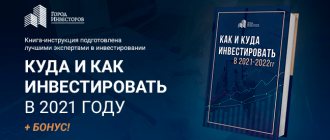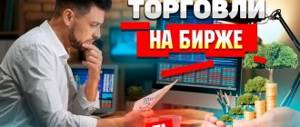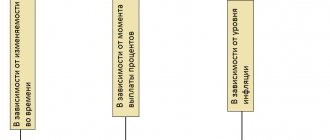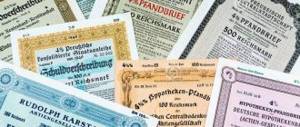When the words trader or broker are mentioned, people far from the topic often have associations with men in formal suits, driving expensive cars and with all the corresponding attributes.
This is partly true, but a modern private trader is just a person with a computer or even a smartphone, and it doesn’t matter what he looks like.
In addition, it has long been known that people in formal suits most often work for people in shorts and T-shirts.
From the article you will learn:
- What is trading
- Why is trading needed?
- Skills a trader cannot do without
- Features of Internet trading
- Types of trading
- Famous traders
- Let's sum it up
What is trading in simple words
Quite simply, stock trading is the buying and selling of assets to profit from price fluctuations. Bought cheaper, sold more expensive - classic speculation. You can also make money on falling markets using margin trading.
Where do they sell?
Regular traders trade securities through brokers or other intermediaries. They either trade stocks on their own behalf using clients' money, or they become intermediaries and connect the trader with a liquidity provider for a certain percentage.
Today, trading has completely gone online. To join trading, you need to enter into an agreement with a broker and download special software to enter the market.
How traders work
Investing and trading are two completely different methods of making a profit in the financial markets. Both seek to make a profit by participating in trade.
But if investors strive for greater profits in the long term, traders, on the contrary, are content with relatively small profits, but get results quickly.
Required skills and knowledge
A trader candidate will need a variety of skills to succeed in this highly competitive and high-risk trading field.
My personal rating of must-have skills for trading includes the following:
- Analytics. The ability to quickly and accurately analyze data is a skill every trader needs. 80% of trading consists of analyzing price charts. Therefore, a trader needs to develop his analytical skills in order to recognize trends in charts more effectively.
- Observation. The desire and ability to search for information that affects the quotes of securities and currencies is another necessary condition. A smart trader creates a personal calendar of economic releases that may affect the price of his exchange assets. Technical indicators always lag the market. Without the ability to correctly interpret news in order to accurately predict price movements, you won’t be able to trade much.
- Control. In trading, composure and the ability to abstract from emotions are important. And emotional trading is a casino.
Simply put, becoming a trader requires the ability to analyze. Formal education in economics/business/finance does not make you successful at trading.
The lion's share of success is personal analytical skills, as well as the ability to concentrate and concentrate. And, of course, the ability to regulate emotions so as not to lose your head in tense moments.
Who can become a trader
Expert opinion
Vladimir Silchenko
Private investor, stock market expert and author of the Capitalist blog
Ask a Question
Advertising says everywhere: “Anyone can do it!” Anyone can register with a broker, deposit money into their account and start earning money. This is wrong. Everyone can invest. There are ready-made analytics and examples of portfolios that will work for everyone. But this is an investment. Active trading has different specifics.
Let's take Michael Berry for example. This is one of the people who predicted the collapse of the housing market and the crisis that followed it in 2008. Everything was clear on the price charts - growth, a nice bullish trend and all that. But after doing his research, Burry noticed something was wrong and opened several extremely profitable short trades at the right time.
What I'm getting at: I am the average level, you are the average level; Michael Burry is not your average trader. The average trader keeps up with the trend, Michael Berry is looking for his own ways. This must be taken into account when choosing a trading strategy.
The most famous traders in Russia and the world
Considering the peculiarities of the formation of the Russian stock market, there are not very many stars here.
Although some have achieved good success in trading, for example:
- Alexander Elder. One of the richest Russians. Today he is mainly engaged in paid consultations and conducting seminars and trainings, but he began his career as a trader. Using the proceeds from trading, he founded the organization Financial Trading Seminars Inc, with which he later moved into the field of education.
- Alexander Gerchik. Started trading in 2003 while in the States. Soon he moved to Russia, where he continued to trade, and later joined the management team of the Finam holding. In 2015, he founded his own brokerage firm, Gerchik&Co, and began trading seriously.
- Alexander Rezvyakov. He started investing in mutual funds in 2003, but later realized that this was not for him and became interested in active trading. He is famous for the fact that in 2011 he earned almost 1,367,666 rubles in one trading day.
Among the Western meters of stock speculation, I would like to note the following trading characters:
- Paul Tudor Jones. A precursor to the infamous Black Monday, the stock market crash of 1987. Predicting a price crash, he dumped the losing stocks and rode the bear market, earning about $100 million. Contemporaries and colleagues appreciated his merits so much that five years after this event they appointed him chairman of the New York Stock Exchange (NYSE).
- George Soros. Conspiracy theorists consider him one of the most influential members of the planet's shadow government, but in trading circles he has earned the nickname "The Man Who Bankrupted the Bank of England." In 1992, he collapsed the pound, opening short bets totaling $10 billion. Earned $1 billion net.
- Jesse Livermore. Old school trader. Predicted the Great Depression and the stock market crash of 1929, earning what was then a whopping $100 million, equivalent to billions today. One of the forefathers of technical analysis.
Books that a novice trader should read
People always want secret wisdom. They had heard stories of private libraries buried deep underground, guarded by genetically enhanced ninja monks, where only a select few were allowed to enter.
Whether it’s one of the forums, or VK, or another social network, you can always find a corner where gurus share secret secrets with their followers. These trading monks jealously guard their trading secrets, revealing them only to those who are worthy or have brought money to the master.
But 99.9% of what forum gurus will tell you about trading is in these books:
- Burton Malkiel A Random Walk Down Wall Street. A great guide for beginners." The book has gone through 10 reprints, and this in itself speaks of its usefulness and relevance. Everything about trading is well explained and accessible to any level of understanding.
- John J. Murphy, Technical Analysis of Futures Markets. A classic of trader's reading. One of the most comprehensive books on technical analysis that I have ever come across. It's chock full of prepared patterns. Of course, out of habit, your eyes may bleed, but I still recommend reading it from cover to cover.
- Kurtis Face "Way of the Turtles. From amateurs to legendary traders." This is a masterpiece of understanding market psychology. It is not enough to master the skill of reading technical indicators in order to find the right entry and exit points. It is equally important to master your emotions and understand what feelings govern other market participants. The psychological factor of trading is an unknown variable that instantly breaks all logical structures. To master trading, you need to learn how to read moods.
- Jack Schwager "The New Market Wizards" An interesting collection of interviews and debriefings from the coolest traders of our time. Each interview is a separate example of a successful and unsuccessful deal, where everything is discussed - from prerequisites to consequences.
- Steve Neeson, Beyond Candlesticks. New Japanese methods of graphical analysis". Top material. In the simplest and most accessible language, the author consistently teaches how to work with a bare price chart, ahead of technical analysis indicators. It sounds scary, but it is described in a very accessible and understandable way.
Stage Three: Unexpected Discovery
Hundreds of indicators and strategies have already been studied, dozens of books have been read and hundreds of tips have been used, your brain seems to be inflated like a big ball, and then something comes to you... it’s not about them. The problem is not at all with indicators and strategies.
There is no miracle strategy or magic indicator, and there never was. You can also make money using one moving average. Or on stochastics. On banal candles, or trend lines.
Yes, on anything!
What is important is the psychology of trading, the ability to manage risks and time. And not all sorts of arrows, lines and squares.
Start studying articles about money management and risk management. And then you understand that successful strategies with guaranteed earnings, or indicators that never fail, simply do not exist.
You are shocked.
It turns out that not a single indicator can reliably indicate where the price will move. They give erroneous signals much more often.
It becomes clear to you that the indicator, which is just a formula, most often shows past movements. But he cannot predict the movements of the current market.
You have to give up your dreams of a fabulous indicator that predicts future movements. The understanding comes that looking for next mentors also makes no sense.
Types of trading
The main ones are below.
Financial
Financial trading is no different from any other form of trading. It is about buying and selling assets in the hope of making a profit.
Financial trading is the buying and selling of financial assets. Trading is carried out in one of two ways: through the exchange or through the cash desk of a commercial structure (bank, management company).
Algorithmic
Computers and all kinds of artificial intelligence today are actively launching their silicon tentacles into all spheres of human life. Investments are no exception. An algorithm is a set of specific patterns or rules that trigger a particular scenario of the trading process.
Simply put, in algorithmic trading, a computer trading program thinks instead of the trader. It analyzes prices and opens/closes orders in predetermined volumes. In theory, a trader can sit back and relax while his trades trade themselves.
However, I don’t yet see a bunch of people suddenly becoming millionaires from such trading. This means that the bots perform not so well.
Internet trading
Online trading is basically the process of buying and selling financial products through an online trading platform that we are talking about today. The view of the stock exchange as a trading pavilion, where everyone is shouting, calling and receiving faxes - this is footage from the distant past. Now there are server blocks there, and traders trade through PCs and mobile gadgets.
Failures
Gradually you learn to cope with drawdowns. Attempts to win back losses lead to impulsive transactions. Further increasing losses.
Trying to see a trend in each graph, especially if there really isn’t one. And you clung to the trend over and over again, with the confidence that it will remain the same. You constantly entered the market hoping for a price reversal, but it didn’t even think about reversing.
You begin to arrive at your system, which includes several components. The system fails and often produces unsuccessful transactions, the attitude towards which has changed. Now everything is perceived much calmer, because there is no one to blame but yourself.
The system didn't work this time, no big deal. Everyone has losses and losses. We must move on. It is necessary to gain experience and hone the system.
You begin to keep a balance for a month, a week. You understand that earnings per day or 1 trade are not at all important. What is more important is what balance is formed per month, quarter, year.
Now don’t look at screenshots of other people’s transactions at all, it’s no longer interesting.
You know that you can show a successful trade and hide a losing one, creating the image of a great trader.
Features of online trading
Online trading is fast and easy. But due to the low threshold, a lot of amateurs fall into it, who do not take into account the peculiarities of online trading and suffer losses.
By the mid-to-late 2000s, most financial businesses finally moved online. This is how the virtual stock market that we all love today was formed.
Advantages and disadvantages
Advantages of online trading:
- Convenience and flexibility. Online trading is very convenient. We can place buy and sell orders even from our smartphone. You can trade from anywhere in the world where there is internet with a more or less decent ping.
- There is no dependence on the broker. The times of office managers have sunk into oblivion. Today, a good broker is an intermediary who directly brings together a trader and a liquidity provider. Quotes are drawn on the exchange in real time. Everything is done in a split second. If you don’t like the conditions or quality, choose another broker. So both residents of megacities and residents of distant fly-by-night towns (no offense for being rude) - everyone has equal access to the market and trading.
- Benefit. Competition among brokers today is high, so they are literally forced to compete with each other. One lures with narrow spreads, another with low commissions, a third with a low minimum deposit, a fourth with long leverage, and a fifth with bonus money and preferential conditions.
Disadvantages of online trading:
- Risk. Online trading is not perceived as something serious at first. Of course, sweating in the manager’s office, squeezed into a business suit, and sitting at the computer in a robe and tattered underpants are different degrees of risk awareness. Therefore, it is often difficult for a poet to stop; many quickly merge.
- Errors and connection problems. A purely technical problem, which, however, can ruin more than one successful transaction or prevents you from exiting an unsuccessful one in time. Broker's server, Internet provider, PC or gadget - at any moment one of the links can fail. And then all the copper basin trade.
As can be seen from the above, online trading has both advantages and disadvantages, and if you are slightly familiar with technological progress and have a little understanding of finance, then you have no contraindications for trading.
Free Guru
You manage to find a friendly guru and bombard him with a million questions. He readily shares his experience, but again tells banal things that you know without him.
Everything starts again from scratch. Questions like: trading - what is it and what is it used with. And oh my God, I've never heard that wording before.
Resistance/support. All this is already familiar, but it doesn’t work at all. Why does he talk about this again and again? Your expectations have once again not been met. The Free Guru probably has a successful strategy, but he doesn’t want to share it for free.
Such a beast!
You try to dilute it with useful advice, but you can’t really get anything out of it. We'll have to leave him alone.
When I posted videos on my YouTube channel, there were some questions like this.
Guys, don't be offended.
But we all want cheaper, better quality and free stuff.
But, as the experienced ones among you have already experienced the hard way, even for a fee they give you a pig in a poke.
Types of software for online trading
To trade on the stock exchange, you need a web terminal. There is everything from trading tools to analytics. All trading programs can be divided into 3 main groups.
Software for beginners
First of all, these are built-in indicators and oscillators. They are easy to use and provide a fairly accurate picture of the market, accessible even to beginners. This group can also include various advisors. Not those that open positions for the trader, but those that simply advise, give signals when it is better to enter and exit the market.
Software for professionals
Professional trading software often consists of complex proprietary indicators. Traders develop them, customizing them for a specific trading asset, trading time, time frame and other narrow parameters.
Automated trading software
Guided by the classification of professional trader Alexander Elder, I will divide software of this type into two groups:
- Black boxes. They analyze quotes, open and close transactions independently, or issue signals for the trader. In this case, the program will find exhausts in the logs. That is, then you won’t be able to take a debriefing to optimize your strategy. The choice of amateurs who want to make money by trading, but do not want to get involved in analysis.
- Gray boxes. They do the same as blacks, but at the same time write explanations for their actions in the log. After the end of the trading session, the trader can analyze the logs of successful and unsuccessful transactions to understand the causes and consequences.
Of course, with the right approach, third-party software can increase profits from transactions. But if you can’t even read the gray box log and comprehend this information, it’s better to postpone getting acquainted with it until later and brush up on your trading theory.
Where did threading come from: the history of a simple thread
Eyebrows have a strong impact on the attractiveness of your face. Beautiful and well-groomed hair attracts the gaze of others. Even the brightest makeup will not help you look impressive if your eyebrows are not shaped. Even in ancient India, female representatives wondered how to put their hair in order. This is how the procedure for eyebrow correction with thread appeared.
At that time, in many eastern countries it was believed that the absence of unwanted hairs on a girl’s body was a sign of her innocence. And the ancient Persians claimed that a girl becomes a woman only after a ritual to rid the skin of excess vegetation using a thread. Therefore, beauties, especially before the wedding, took the issue of hair removal seriously and carried it out in every possible way.
Recommended reading:
- What not to do after eyelash extensions
- Which eyelash extension to choose for yourself
- Eyelash care: advice from professionals
This is how a procedure called “trading” appeared. Currently, the technique of hair removal with thread is in great demand and is presented in almost every beauty salon. Its popularity is due to its effectiveness and safety.
What is social trading
Social trading, as the name suggests, works on a social network model. The only difference is that instead of sending each other selfies or food photos, people share their ideas.
Here traders interact, observe the trading results of other professionals and brainstorm market situations in real time.
Social trading scheme
Being not a very experienced trader, we can study the open statistics of the “Tops”, choose our “racing horse” and, by paying a small commission to the platform, copy its transactions.
Simply put, a pro trades, and the system copies his trades and invites us to repeat after him. Our task is to find a successful trader and follow them, copying their transactions.
TOP best platforms for social trading
Personal rating of trading platforms below.
eToro
Perhaps a top tip for a novice Russian-speaking trader. The minimum deposit is $200, it has its own web platform and applications for iOS and Android.
Working instruments: CFDs on indices, shares, ETFs, commodities, bonds, cryptocurrency. eToro is not a market pioneer, but its Copy Trading trading system is the benchmark for what we call social trading.
MyDigiTrade
Another interesting platform for trading futures, options and CFDs, founded in 2010. This is a copycat platform created by independent traders. The structure is similar to eToro's Copy Trading.
There are tools for analyzing the success of signal providers, as well as many proprietary options for money management. The downside is the small number of signal providers (a little more than 200 so far).
Naga Trader
An interesting social trading platform that works with CFDs on stocks, ETFs, indices, commodities, futures, cryptocurrency and even in-game items. It is simultaneously a social network, a social trading platform, its own transaction copying system, and even its own Naga cryptocurrency (NGC).
TradingView
I would especially like to mention the TradingView cloud platform for trading. Here you can trade futures and currencies. It has its own tools for price analysis and charting.
The terminal is closely integrated with the forum, allowing you to quickly copy indicator indicators and immediately exchange ideas with other traders in a common thread or personal chat in real time.
Advantages and disadvantages
In my opinion, the main benefits of social trading include:
- Quick access to reliable trading information. Platforms like Social Trading bring together traders from all over the world who monitor the market around the clock, find relevant information and sort it out piece by piece. Official analytics will be released later.
- Quick understanding of the trading market. The advantage of social trading is that from the first moment you learn from a live example and watch the work of real investors.
- You study and earn at the same time. Social trading platforms allow you to learn from experienced investors and at the same time copy their trades to make money yourself. In this case, the specialist himself gives permission for people to copy his trading signals. The risks, however, are entirely on the shoulders of the copyer.
Disadvantages of trading:
- Addiction. When you receive relatively easy money that another pro actually earns, you involuntarily relax and begin to consider yourself a successful trader. There is a temptation to invest the money you earn in something. And then it turns out that in fact you are not trading very well, the market outside of social trading platforms is inaccessible to you.
- Taking someone else's risk. Pros make mistakes too. But they move huge sums, so they can withstand drawdowns. This is acceptable and part of their plan. On the other hand, a trader who copies a trade usually replenishes the deposit with the minimum amount and, if unsuccessful, loses everything.
Currency pairs
It's time to talk about the main element of Forex. Currency pairs, also known as quotes, are the ratio of one world national currency to another. In a pair, naturally, they can only be different.
When buying the Euro/US Dollar pair for euros, you are selling the dollar. By selling it, an exchange occurs. Accordingly, during the holding period, in order to win, we need the euro to rise against the dollar. Traditionally, pairs are divided into basic, cross and exotic.
Major – those whose base is the US dollar, USD. This is the USD against the euro, British pound, Australian and Canadian dollars, Japanese yen and New Zealand dollar. This also includes USD/CHF – dollar and Swiss franc. All the rest are not included in the “base”.
Cross rates are the intersection of the specified currencies with each other, but without the use of the American dollar. For example, Japanese yen/Swiss franc (JPY/CHF). They are also easily quoted and traded, taking into account their characteristics and correlations.
Ways to gain trading knowledge for a beginner
Everything works - I tested it myself.
Self-study of trading basics
Read books and articles about trading that are available on the Internet. Seriously, Google search is a great way to find educational reading material today.
This is more than enough to master the basics and start trading on a demo account. This simulation of real trading will allow you to identify your gaps in education, after which it will become clear where to move next in trading.
Online training
Online courses and educational webinars on trading usually cost money, sometimes a lot, but can be very useful.
Mainly due to the fact that the speaker can answer questions or messages in the chat, clarifying difficult points and focusing on what is important in trading.
Attending in-person classes
Seminars can provide valuable information about the general market and specific types of investments. Most seminars focus on one specific aspect of the market and how the speaker has achieved success using his or her own strategies over the years.
Examples of classes from Dan Zanger and Mark Minervini that I have attended and reviewed in detail here on the site. Not all trading seminars have to be paid for. Some are provided for free, which can be a useful trading experience, just be very careful about what they sell.
Pursuit of information
The best results will be shown by the trader who is better informed. Many people misunderstand this expression and strive to snatch some insider information or a paid super strategy.
In fact, the best way to absorb new things is to read topical books from professionals. For beginners, we recommend three books that you can buy or download online by finding a torrent:
- Forex trading for beginners, Michael Archer.
- 1000 and 1 lesson in currency trading, V. Simonyan.
- Currency trading and intermarket analysis, Ashraf Laidi.
How to complete trading training for beginners: step-by-step instructions
Millions of neophytes try their hand at the stock market every year. But most leave a little poorer and a little wiser, never reaching their potential.
Most of those who fail at trading have one thing in common: they have not mastered the basic skills needed to tilt the odds in their favor. Take enough time to study them, you will have everything in your hands to make a profit on the exchange.
Choosing a learning method
Learn to choose what you need about trading:
- accelerated online courses;
- financial items;
- books about the stock market;
- textbooks for universities and colleges.
There is a lot of useful information about trading there. Don't get hung up on one thing. If you can’t master the textbooks, read books with examples. If it’s not clear, sign up for an online course.
Everything is clear with the basics and if you want specifics, choose articles from professional traders. Now you understand the language they are written in, you can use the trading information to your advantage.
Mastering the market and the main concepts of stock trading
Learn the basics of technical analysis, support and resistance levels. Apply them to real price charts. Learn the basics of fundamental analysis. Just for yourself, try to predict where the price of several assets you like will go.
At first it seems that all this is chaos, which can be influenced by magical rituals. But there is a system. And guys like Warren Buffett and Peter Lynch guarantee that.
Studying the trading terminal
Find a good online broker, open a brokerage account. Deposit money and go to the trading platform (the broker may provide a desktop version for PC, programs for Android and iOS, and a web platform).
Familiarize yourself with the account interface and select the desired tool. You can visit Youtube to watch videos and read live comments about the trading terminal that interests us.
Learning the basics of risk management
Risk management in trading helps reduce losses. Risk is the likelihood of losing a lot of money in pursuit of greater gains. Each trading asset has its own return/risk ratio. Plus, there must be trading rules regulating what to do in certain cases.
By properly managing risk, a trader builds a foundation of low-risk, low-yield assets, gradually increasing the percentage of risky trades in order to trade more often and earn more money to reinvest. Although specific measures largely depend on the trading style.
Introduction to the basics of fundamental analysis
Fundamental analysis is a way of looking at the market as a system of economic, social and political factors that influence the supply and demand of an asset. In other words, once we master fundamental analysis, we will be able to determine which economies will collapse and which will grow.
For those who operate only using technical analysis methods, such global trend reversals often come as a surprise. Otherwise there would not have been so many victims of economic crises.
Study of technical analysis
Unlike fundamental analysis, which evaluates an asset or an entire market from a global perspective, technical analysis focuses on price movement patterns, trading signals, and assessment of the current strength or weakness of a security or other asset.
Opening a demo account and applying the acquired knowledge in practice
To practice trading without risking real money, you need an online account. Not all brokers provide this service. Therefore, when studying broker ratings, we look to see if our candidate has a demo account.
Although it doesn’t really matter where you train. Of course, it’s convenient that you don’t have to retrain later, but in general you can train on a demo account with one broker and trade with another. No one will punish you for this.
Mentors
While browsing the forums, you find mentors - teachers. There are many of them and the advice from them seems to be quite good.
You open Google and everything is replete with phrases like, the stock market is a course for beginners. Or: playing on the stock exchange - where to start learning on your own. Sound familiar?
Many offer free courses in addition to the paid book. After purchasing the book, you come to webinars and lessons.
Attention! Having visited them, you find out that this is only a beginner course, and there is also an advanced one, but paid for several thousand rubles.
It is more complete and better, and the information there is not some kind of abstract, but more and more specific, to the point. You pay for it. But this is not enough, you need to buy something else.
Come to the need for individual training, but you want to find it cheaper. You pester those who show screenshots of their earnings screens with questions on the forums.
Misconception! These people know exactly how to make money, you need to get this secret too.
Where to start as a trader
Brief instructions on trading below.
Choosing a broker
There has never been a better time to be an investor. Competition among online brokers is fierce, which means costs are falling and quality of service is increasing. But choosing the right brokerage account depends on our individual priorities.
Some investors are willing to pay higher trading fees for a modern platform with unique trading signals and technical analysis indicators; others consider the costs unnecessary and trade on minimal accounts, without personal advisors and insider analytics.
To evaluate a broker, you should consider the following factors:
- expenses (spreads, commissions, additional services);
- minimum deposit;
- leverage (is there any at all and how long);
- your trading style.
Many brokers have their own promotions and personal trading conditions.
Rating of the best brokers for new traders
There is no ideal broker for trading. It cannot be by definition. Some people need narrow spreads, some need top analytics, others need a fancy terminal.
If a trader is a complete beginner and wants to quickly start making money on low-risk assets, so that during training the money does not just sit there, but also brings in some income, then here is my top tip:
- VTB;
- Tinkoff;
- Alpha.
In my opinion, these are the most optimal brokers for starting investments. Perhaps I missed someone and there are better offers. Then write about it in the comments.
Opening a trading account
Opening a brokerage account may seem like a complicated process, but it is actually the easiest step in trading.
On the main page of the selected online platform, you will not miss the offer to register an account. This is followed by step-by-step instructions, where everything is written, chewed and illustrated.
The main responsibility at this stage is to choose the type of trading account (DD, where all orders are executed by the broker, or NDD, where the client trades without the direct participation of the broker). Accounts are also divided according to the minimum deposit and the type of remuneration that the broker receives.
Typically, the larger the deposit, the less you pay. The broker can take his money in the form of a spread or a fixed amount from each transaction.
Gaining access to start trading
After choosing a broker and account type for trading, you can register. By filling out the form and submitting the application, we get access to your personal account. Usually, the first thing the broker suggests is to top up the deposit and authorize the account. After this, you can freely deposit and withdraw a day directly from your bank card.
Download and install special software
Everything you need for trading is on the broker's website. The broker can provide standard software based on MT4/MT5 or its own programs such as ROX or Takion. The former are usually free and are used more often. The latter are available in the form of demos or stripped-down versions, but you have to pay for the full version.
Analysis of information about exchange rate dynamics
Most traders start with a thorough analysis of a company, looking at publicly available information, including earnings reports, financial statements and SEC filings, as well as external research reports from professional analysts.
Much of this is provided by the broker itself, along with the latest company news and risk ratings. To begin with, it is better to avoid assets that are too volatile and work slowly, choosing one or two stocks and investing the amount of money we are willing to lose.
Generating a request to open a deal
Don’t despair if all the trading numbers and charts with their meaningless phrases don’t make sense to you. Refer to this cheat sheet:
- Ask Price: The price a buyer is willing to give for one share.
- Offer price: the price at which the issuer is willing to part with the stock.
- Spread: The difference between the highest bid price and the lowest bid price.
- Market order. A request to buy or sell shares at the best available price.
Trading for growth is a Buy order or a green arrow up. Short (margin) trading is a Sell order or a red arrow. Thanks to the efforts of the broker, we do not see how it all works. We simply indicate in the window the amount of the asset to be purchased (usually traded in lots) and select the direction.
Fixing the financial result of the transaction
It is not always possible to control price movements in the terminal constantly until the transaction is closed.
Therefore, control tools were created:
- Stop loss. It turns on as soon as losses reach a certain number of price points and closes the deal. There is also such a variation as a floating stop loss. It follows the price up, and after it goes down, it starts counting points.
- There is also a take profit. He closes the deal and takes the money when the trader's desired number of price points has been passed. Simply put, we risk not fully squeezing the trend in order to get a bird in the hand instead of a pie in the sky. This is often more practical in trading.
Signals
After reading a bunch of books and recommendations on forums, your head is a complete mess. It’s not entirely clear how to deal with this. Many strategies and hundreds of indicators that contradict each other. Find a site that offers to provide signals for a fee.
Comment! By the way, when I only had a YouTube channel, I also wanted to sell signals. And then I realized that people wouldn’t be able to use them properly. They will always make mistakes and blame me.
Here we need something different. I haven’t figured it out yet, so no signals.
And the cost is small, 500 rubles. That’s what you need. And most importantly, it seems to work! Gradually find a group on VKontakte that offers sending out free signals. To gain access you only need to register using the link.
Register and continue to pay for paid signals. Continue searching, reading all the information you can. Mark successful strategies and indicators.
You browse various sites with robots or signals. You continue to actively communicate on forums, pestering everyone with questions.
Buy or download inexpensive proprietary strategies or “secret” indicators.
Trading Strategies
The analysis process and trading style largely depend on the chosen instrument and the time period on which we trade. I will focus on the main trading strategies.
Scalping
Scalping is one of the fastest and most aggressive strategies. It is based on the use of various price impulses caused by surges in supply and demand. Scalpers try to hold their positions for a short period, thereby reducing the risks associated with fundamental factors.
In addition, the scalper does not try to trade in large volumes. He trades small amounts, but often (for example, closing up to a dozen or more orders within one hour). Since the profit margin per trade is low, scalpers tend to the most liquid markets to increase the frequency of trades.
Intraday
Day trading is perhaps the most popular style of trading. This is a method of buying and selling securities within one day. There is only one condition - positions cannot be transferred to the next day (this is a potential risk of a price reversal against us if something important happens between sessions and can affect the quotes).
More often than not, traders start with intraday trading, although (if you want my opinion) this style still works better for experienced traders. For beginners, it is better to take longer graphs.
Medium term
Medium-term trading - buying and selling shares for a period from several weeks to several months. The result will take longer, but the risks are much lower. In assets with average volatility, it is easy to identify a stable trend and make money on it. There is only one downside to this style: sometimes you have to wait a long time for suitable trading signals.
Long term
Long-term trading is actually investing. This style involves fundamental analysis and identifying major ebbs and flows. On average, traders follow a trend from several months to a year or more.
Prop trading
In this case, a financial company or commercial bank trades on the exchange. Only she invests directly in the market, and does not live on commissions from clients, trading on their behalf.
A prop trading company employs professional traders who trade not their own money, but the money of this company. Or the trader can make a basic security deposit, and the prop firm increases it. In this case, the trader’s loss is limited to the amount of the deposit.
Technical
Technical trading is primarily about focusing on price charts and technical indicators. The main indicators are price patterns, price convergence and divergence, as well as market volumes and overbought/oversold levels.
Fundamental
Fundamentalists ignore ripples and waves. If they see in their forecast that the market or company will be successful in 20 years, they will buy these shares, even if they are worthless ballast for the next 10 years.
Traders analyze corporate events, management efficiency, personnel appointments, general market conditions, the prospects of the industry as such, and other similar data.
Swing trading
Swing traders hold their positions from several days to several weeks. In this time window, you can catch a more or less stable trend, and the frequency of trading signals remains at a more or less acceptable level. The risk is still quite high, but you can earn more often in order to reinvest more efficiently.
Moment
Momentum trading is a technique in which traders buy and sell in response to price impulses. The pulse can be timed for hours, days, weeks or months.
The first step that traders usually take is to determine the direction of the trend they want to trade in, and then, using an economic calendar or a classic momentum indicator, set an entry point.
Trading tools and techniques
How should the thread be woven to carry out the threading procedure? We are sure that you have asked yourself this question. We will definitely answer it and tell you about other features of using this technique.
The procedure itself for removing hairs with a thread comes from the Ancient East, but its name - “threading” - is of English origin and is translated as “thread, fiber” and “stringing”.
To implement the technique, a thread made of cotton yarn is suitable, it must be strong, otherwise it will tear during the session. If you plan to thread at home, give preference to natural cotton material. The advantage is the addition of silk or nylon to its composition, because in this case the strength will be even higher. The selected thread should not be smooth, as then the hairs will slip off and it will not be possible to hook them.
Experienced specialists prefer to use threads made from twisted nylon fibers. Their advantage is reliable fixation of the hair and the absence of slipping. In addition, professionals recommend using special thread holders during the procedure, thereby minimizing damage to the skin of the fingers. In this case, trading will become comfortable for you.
The thread is twisted between the fingers in a special way. For clarity, we attach the picture above, and we will describe the twisting process itself step by step:
- Choose a thick cotton thread that is no less than 40 cm and no more than 50 cm in length.
- Connect the ends together and tie them into a strong knot. Trim off the excess. You should now have a closed ring.
- Take it with both hands, secure it between your thumb and forefinger and twist it several times to form a figure eight. It is very important to hold the knot firmly during this time to prevent it from moving.
- As a result, the thread will look like two triangles, between which the twisted section is located. The latter should move easily when moving your fingers.
If a special tool is used, the thread is fixed with hooks instead of fingers, and the twisting process is similar to that described above.
The main movement is the expansion of the ring on one side and narrowing on the other as a result of the work of the fingers.
The movements of the thread should be directed strictly against the growth of hairs. Unwanted vegetation becomes entangled in the twist and, thanks to your efforts, is pulled out along with the roots.
If you decide to try threading on yourself and are doing it for the first time, we strongly recommend choosing legs for waxing. In such a large and inconspicuous area you can fill your hand.
You can perform the hair removal procedure using a thread not only for yourself, but also for your acquaintances, friends, and your family. We advise you to complete professional courses that will help you learn the nuances of trading techniques. Training will help you gain first experience and eliminate the fear of using it in the future. However, many girls still managed to successfully master this method of removing unwanted vegetation. You can find a visual aid on the Internet.
As an option, we suggest that you familiarize yourself with the trading technique using a video tutorial on the YouTube website at the link:
Once you have mastered all the basics of the hair removal procedure with a thread and gained enough experience at home (no matter on yourself or your loved ones), you will be able to get rid of unwanted hair on any part of the body. Not only thinned, weak hairs will succumb to you, but also strong ones. Each time the procedure will take less and less time. The result will certainly please you.
The smoothness of the skin remains for three weeks, and with each session the hairs will become thinner. In some salons you can find a special device for trading. Undoubtedly, with it, hair removal is carried out faster and without much effort from the specialist. If you wish, you can purchase it for your home. But we strongly recommend that you first learn how to use this device so as not to harm yourself.
How to make money from trading: expert advice
Various guides and advice on trading are a dime a dozen. Here are my TOP 5 simple tips for investing in the stock market:
- Leave your emotions at the door.
- Choose companies, not stocks.
- Plan in advance how to trade during calm periods and during periods of peak volatility.
- Always prefer positions with minimal risk - leave high risks for now for experienced traders
- Avoid excessive trading - trade only according to plan, even if the planets suddenly align and it’s unrealistic.
Exotic couples
Exotic pairs are the ratio of the dollar to currencies that are not included in the group of major or crosses. In fact, it is any other world currency, be it the Mongolian tugrik or the Turkish lira. By the way, the Russian ruble is also considered exotic, so it is worth trading with it only with extensive information preparation.
Experienced traders avoid such coins. The low economic activity of many countries leads to the fact that there are simply no real trade ties between them and the United States; accordingly, there are no points from which to base your forecast.
Pairs where the dollar works with a certain economically developing country, or with a state that has correlations with the cross currency can be considered more or less adequate. For example, dollar/Danish krone. Due to Denmark's proximity to the European economy, the dynamics of its currency follows the euro. But it’s also not worth taking risks without proper preparation.
Real reviews
There are so many people, so many opinions about trading. And if we learn trading, then it is better to listen to those who ate the dog at it.
You don’t have to be a rocket scientist to trade,” the Oracle of Omaha said about the stock market. Warren Buffett emphasized that investing is not an intellectual game in which a guy with 160 IQ beats a guy with 130 IQ. And that's the beauty of it."
He also owns another phrase that I really like: “Rule number one: don’t lose money. Rule number two: don't forget rule number one."
A certain George Soros (maybe you've heard of this) said this about the stock market:
“Markets are constantly in a state of uncertainty and money is created by investing in the obvious and betting on the unexpected.”
And the master of the American stock market, Benjamin Graham, said that on the stock exchange, an intelligent investor sells to optimists and buys from pessimists.
Required Skills
So, what does a trader need in 2021? Good theoretical basis . Knowledge of trading rules. Trading algorithm. Understanding how trading and the exchange itself works. Ability to plan. Accumulated capital. Constant analysis of transactions on the stock exchange. It is necessary to keep statistics of your transactions and note your mistakes. Develop new trading strategies. Draw conclusions.
If you want to have all the skills of a successful trader, we recommend watching programs from Alexander Gerchik and choosing the one that suits you.
Stage four: stable trade
Now the time has come when you work consciously. Following the framework of your system, the one that you yourself developed for yourself, having tested it for months of trading. Now you are not looking for free trading strategies for beginners on the Internet. Now losses are perceived calmly, as are earnings.
For you, this is an ordinary job, the job of a trader. Now you can stop at the right time when unsuccessful trades occur. You work calmly, without nerves. Your predictions now come true much more often; you can predict when the price will break through support, bounce off it, or turn into a false breakout.
Now you know a lot about the news. You know where to look for them and how they will affect the market. There is a widget on your desktop or smartphone that shows the opening hours of major exchanges. But you remember it anyway.
Tabs from economic calendars with news are open in the browser. You are interested in reading Bloomberg and Forbes. You have thoroughly studied your working tool, it is clear where to use it, and when it is better not to open the trading program at all. You are no longer looking for indicators.
You have several that you use on your chart from time to time. Mainly to test your own ideas. But basically do without them, there are only a few lines on the graph, it is almost empty.
Sometimes you install a popular oscillator, such as RSI, analyzing prices in consolidation. Now you have your favorite money pairs. Each with its own politics, culture, society and, of course, economy.
The deposit remains in place. Sometimes for several months. It happens that you increase it quite well, or again slide down to the initial amount.
You understand that the work is going well. Over the past month, you have not lost any money at all.
You are increasingly successful in transactions with good profits, although failures also occur. Although there is still a lot of work ahead, there is no longer that fear in your soul, the deposit begins to grow. Now there is no need to recoup over and over again, the work is built according to plan, without twitching.
Time passes. The deposit continues to gradually increase, and has been like this for several months. Stage 5 begins.











